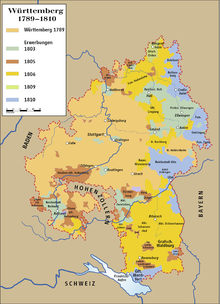Neuwuerttemberg
As Neuwürttemberg were referred from Reichsdeputationshauptschluss in 1803 the new Württemberg territory in which the numerous territorial gains - especially east and south Altwürttembergs were summarized -.
Territorial gains
This included Upper Swabia , which was split up into numerous monastic, aristocratic and imperial city dominions, and the western Allgäu , i.e. the predominantly Catholic areas between the Swabian Alb and Lake Constance , which were only partially integrated into the then largely Protestant Old Württemberg . Quite a few particles had belonged to Upper Austria here . The largest secular territory of Neuwuerttemberg was that of the Counts of Waldburg .
In addition, Neuwuerttemberg included areas in the north and east of Altwuerttemberg, including the former Hohenlohe areas and the former prince provost of Ellwangen .
The imperial cities integrated in 1803 included:
- Esslingen , Reutlingen and Weil der Stadt in the core region,
- Heilbronn and Hall in the north,
- Gmünd , Aalen , Giengen and Ulm (partly to Bavaria) in the east,
- Biberach , Ravensburg and others in the area of Upper Swabia / Bodensee / Allgäu as well
- Rottweil on the young Neckar.
State intermezzo
From 1803 until the final dissolution of the Holy Roman Empire of the German Nation in 1806, there was an independent state of Neuwuerttemberg for a short time, with the seat of government in Ellwangen , in which the estates or the estates assembly of Altwuerttemberg had no say. The elector and Duke Friedrich I of Württemberg ruled both states in personal union until, thanks to Napoleon , he was able to consolidate them into a kingdom and thereby “put a coup d'état” on the annoying constitution of old Württemberg . The political differentiation between Old Wuerttemberg and New Wuerttemberg was no longer applicable from now on, but was occasionally still used for regional delimitation.
The integration of the mostly Catholic areas, which came to Neuwuerttemberg after 1803 and finally to the Kingdom, required special efforts. The equality of the new Catholic citizens had to be secured as well as the equality of the Catholic cult.
literature
- Walter Grube : Stands in Württemberg . In: From the assembly of estates to the democratic parliament . Theiss, Stuttgart 1982, pp. 31-50.
- Bernhard Mann : Württemberg 1800 to 1866. In: Meinrad Schaab , Hansmartin Schwarzmaier (ed.) U. a .: Handbook of Baden-Württemberg History . Volume 3: From the end of the old empire to the end of the monarchies. Edited on behalf of the Commission for Historical Regional Studies in Baden-Württemberg . Klett-Cotta, Stuttgart 1992, ISBN 3-608-91467-6 , pp. 241 f., 246-251, 254-256, 265-266, 269-275, 287, 295, 330.
- Dieter Mertens : Württemberg. In: Meinrad Schaab, Hansmartin Schwarzmaier (ed.) U. a .: Handbook of Baden-Württemberg History. Volume 2: The Territories in the Old Kingdom. Edited on behalf of the Commission for Historical Regional Studies in Baden-Württemberg. Klett-Cotta, Stuttgart 1995, ISBN 3-608-91466-8 , pp. 1-163.
- Volker Press : King Friedrich I. - The founder of modern Württemberg. In: Baden-Württemberg in the age of Napoleon. Volume 2, exhibition of the state of Baden-Württemberg. Edition Cantz, Stuttgart 1987, ISBN 3-922-608-48-5 , pp. 25-40.
Individual evidence
- ^ Walter Grube: Stands in Württemberg . In: From the assembly of estates to the democratic parliament . Theiss, Stuttgart 1982, p. 49f.

